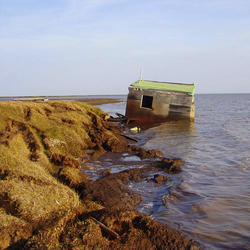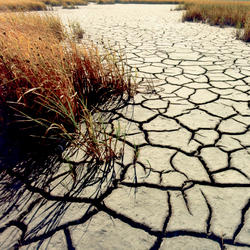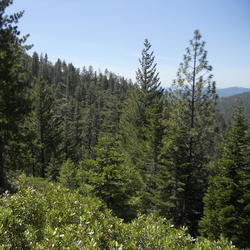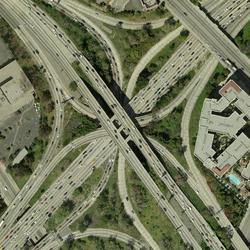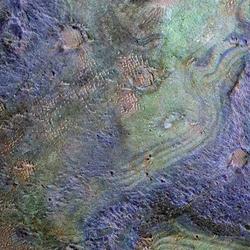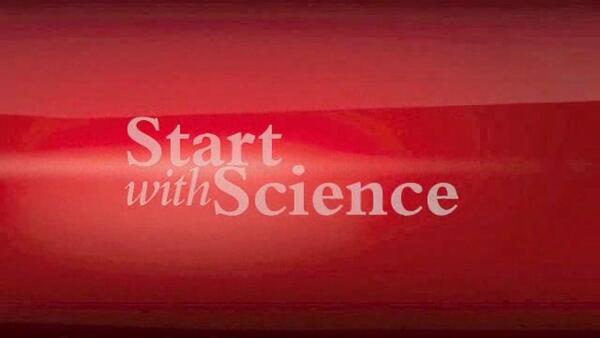Eroding permafrost on Alaska’s Arctic Coast. Inundation of permafrost like this produced subsea permafrost
How do we know the climate is changing?
The scientific community is certain that the Earth's climate is changing because of the trends that we see in the instrumented climate record and the changes that have been observed in physical and biological systems. The instrumental record of climate change is derived from thousands of temperature and precipitation recording stations around the world. We have very high confidence in these records as a whole. The evidence of a warming trend over the past century is unequivocal.
Many types of instrumental records point to a climate warming trend. Our streamflow records show an earlier peak in spring runoff; borehole temperature records in Alaskan permafrost as well as water temperature records on land and sea show the warming trend. The physical and biological changes that confirm climate warming include the rate of retreat in glaciers around the world, the intensification of rainfall events, changes in the timing of the leafing out of plants and the arrival of spring migrant birds, and shifting of the range of some species.
Related
What are the long-term effects of climate change? What are the long-term effects of climate change?
Scientists have predicted that long-term effects of climate change will include a decrease in sea ice and an increase in permafrost thawing, an increase in heat waves and heavy precipitation, and decreased water resources in semi-arid regions. Below are some of the regional impacts of global change forecast by the Intergovernmental Panel on Climate Change: North America: Decreasing snowpack in the...
What is the difference between weather and climate change? What is the difference between weather and climate change?
Weather refers to short term atmospheric conditions while climate is the weather of a specific region averaged over a long period of time. Climate change refers to long-term changes.
How can climate change affect natural disasters? How can climate change affect natural disasters?
With increasing global surface temperatures the possibility of more droughts and increased intensity of storms will likely occur. As more water vapor is evaporated into the atmosphere it becomes fuel for more powerful storms to develop. More heat in the atmosphere and warmer ocean surface temperatures can lead to increased wind speeds in tropical storms. Rising sea levels expose higher locations...
What are some of the signs of climate change? What are some of the signs of climate change?
• Temperatures are rising world-wide due to greenhouse gases trapping more heat in the atmosphere. • Droughts are becoming longer and more extreme around the world. • Tropical storms becoming more severe due to warmer ocean water temperatures. • As temperatures rise there is less snowpack in mountain ranges and polar areas and the snow melts faster. • Overall, glaciers are melting at a faster rate...
How do changes in climate and land use relate to one another? How do changes in climate and land use relate to one another?
The link between land use and the climate is complex. First, land cover--as shaped by land use practices--affects the global concentration of greenhouse gases. Second, while land use change is an important driver of climate change, a changing climate can lead to changes in land use and land cover. For example, farmers might shift from their customary crops to crops that will have higher economic...
What is carbon sequestration? What is carbon sequestration?
Carbon dioxide is the most commonly produced greenhouse gas. Carbon sequestration is the process of capturing and storing atmospheric carbon dioxide. It is one method of reducing the amount of carbon dioxide in the atmosphere with the goal of reducing global climate change. The USGS is conducting assessments on two major types of carbon sequestration: geologic and biologic.
Has the USGS made any Biologic Carbon Sequestration assessments? Has the USGS made any Biologic Carbon Sequestration assessments?
The USGS is congressionally mandated (2007 Energy Independence and Security Act) to conduct a comprehensive national assessment of storage and flux (flow) of carbon and the fluxes of other greenhouse gases (including carbon dioxide) in ecosystems. At this writing, reports have been completed for Alaska, the Eastern U.S., the Great Plains, and the Western U.S. Learn more: Carbon Emissions and...
How does carbon get into the atmosphere? How does carbon get into the atmosphere?
Atmospheric carbon dioxide comes from two primary sources—natural and human activities. Natural sources of carbon dioxide include most animals, which exhale carbon dioxide as a waste product. Human activities that lead to carbon dioxide emissions come primarily from energy production, including burning coal, oil, or natural gas. Learn more: Sources of Greenhouse Gas Emissions (EPA)
How much carbon dioxide can the United States store via geologic sequestration? How much carbon dioxide can the United States store via geologic sequestration?
In 2013, the USGS released the first-ever comprehensive, nation-wide assessment of geologic carbon sequestration, which estimates a mean storage potential of 3,000 metric gigatons of carbon dioxide. The assessment is the first geologically-based, probabilistic assessment, with a range of 2,400 to 3,700 metric gigatons of potential carbon dioxide storage. In addition, the assessment is for the...
What’s the difference between geologic and biologic carbon sequestration? What’s the difference between geologic and biologic carbon sequestration?
Geologic carbon sequestration is the process of storing carbon dioxide (CO2) in underground geologic formations. The CO2 is usually pressurized until it becomes a liquid, and then it is injected into porous rock formations in geologic basins. This method of carbon storage is also sometimes a part of enhanced oil recovery, otherwise known as tertiary recovery, because it is typically used later in...
Which area is the best for geologic carbon sequestration? Which area is the best for geologic carbon sequestration?
It is difficult to characterize one area as “the best” for carbon sequestration because the answer depends on the question: best for what? However, the area of the assessment with the most storage potential for carbon dioxide is the Coastal Plains region, which includes coastal basins from Texas to Georgia. That region accounts for 2,000 metric gigatons, or 65 percent, of the storage potential...
How do we know glaciers are shrinking? How do we know glaciers are shrinking?
Repeat photography and aerial / satellite photo analysis provide evidence of glacier loss in terms of shape and area. The USGS Benchmark Glacier project has collected mass balance data on a network of glaciers in Alaska, Washington, and Montana for decades, quantifying trends of mass loss at all sites. Extensive field data collection at these sites includes twice yearly visits to measure seasonal...
Eroding permafrost on Alaska’s Arctic Coast. Inundation of permafrost like this produced subsea permafrost
 A Record of Change: Science and Elder Observations on the Navajo N.
A Record of Change: Science and Elder Observations on the Navajo N.
A Record of Change: Science and Elder Observations on the Navajo N.
A Record of Change: Science and Elder Observations on the Navajo N.A Record of Change—Science and Elder Observations on the Navajo Nation is a 25-minute documentary about collaborative studies using conventional physical sciences, combined with tribal elder observations to show that local knowledge and conventional science partnerships can effectively document ecosystem change and determine the resulting challenges to livelihoods.&
A Record of Change: Science and Elder Observations on the Navajo N.
A Record of Change: Science and Elder Observations on the Navajo N.A Record of Change—Science and Elder Observations on the Navajo Nation is a 25-minute documentary about collaborative studies using conventional physical sciences, combined with tribal elder observations to show that local knowledge and conventional science partnerships can effectively document ecosystem change and determine the resulting challenges to livelihoods.&
 PubTalk 6/2017 — Effects of Climate Change: A Scientific Path Forward
PubTalk 6/2017 — Effects of Climate Change: A Scientific Path Forward
PubTalk 6/2017 — Effects of Climate Change: A Scientific Path Forward
PubTalk 6/2017 — Effects of Climate Change: A Scientific Path ForwardTitle: The Effects of Climate Change: A Scientific Pathway Forward
- The frequency of extreme and unpredictable weather events is increasing.
- What are the effects of an increase or decrease in carbon emissions?
- What is scientific research projecting for the future of climate change?
PubTalk 6/2017 — Effects of Climate Change: A Scientific Path Forward
PubTalk 6/2017 — Effects of Climate Change: A Scientific Path ForwardTitle: The Effects of Climate Change: A Scientific Pathway Forward
- The frequency of extreme and unpredictable weather events is increasing.
- What are the effects of an increase or decrease in carbon emissions?
- What is scientific research projecting for the future of climate change?
More than 1,500 walruses resting on shore at Cape Grieg in southeastern Bristol Bay.
More than 1,500 walruses resting on shore at Cape Grieg in southeastern Bristol Bay.
An adult female polar bear and her two cubs travel across the sea ice of the Arctic Ocean north of the Alaska coast.
An adult female polar bear and her two cubs travel across the sea ice of the Arctic Ocean north of the Alaska coast.
Data collected from long distance swims by Polar bears suggest that they do not stop to rest during their journey.
Data collected from long distance swims by Polar bears suggest that they do not stop to rest during their journey.
The Northwest Climate Science Center (NW CSC) is a Department of the Interior (DOI) initiative, sponsored by the USGS and jointly hosted by Oregon State University, the University of Idaho, and the University of Washington.
The Northwest Climate Science Center (NW CSC) is a Department of the Interior (DOI) initiative, sponsored by the USGS and jointly hosted by Oregon State University, the University of Idaho, and the University of Washington.
 What's the Big Idea? — Remote Sensing Understand Climate Change
What's the Big Idea? — Remote Sensing Understand Climate Change
What's the Big Idea? — Remote Sensing Understand Climate Change
What's the Big Idea? — Remote Sensing Understand Climate ChangeZhuoting Wu, research ecologist at the USGS Western Geographic Science Center, explains how the USGS uses remote sensing technology to help Tribal communities better understand the effects of climate change.
What's the Big Idea? — Remote Sensing Understand Climate Change
What's the Big Idea? — Remote Sensing Understand Climate ChangeZhuoting Wu, research ecologist at the USGS Western Geographic Science Center, explains how the USGS uses remote sensing technology to help Tribal communities better understand the effects of climate change.
 Climate Change Impacts on Aquatic Ecosystems in PNW
Climate Change Impacts on Aquatic Ecosystems in PNW
Climate Change Impacts on Aquatic Ecosystems in PNW
Climate Change Impacts on Aquatic Ecosystems in PNWThis webinar was held as a part of the Climate Change Science and Management Webinar Series, a partnership between the USGS National Climate Change and Wildlife Science Center and the FWS National Conservation Training Center.
Climate Change Impacts on Aquatic Ecosystems in PNW
Climate Change Impacts on Aquatic Ecosystems in PNWThis webinar was held as a part of the Climate Change Science and Management Webinar Series, a partnership between the USGS National Climate Change and Wildlife Science Center and the FWS National Conservation Training Center.
 Extreme Climate Events and Species Population Dynamics
Extreme Climate Events and Species Population Dynamics
Extreme Climate Events and Species Population Dynamics
Extreme Climate Events and Species Population DynamicsThis webinar was held as a part of the Climate Change Science and Management Webinar Series, a partnership between the USGS National Climate Change and Wildlife Science Center and the FWS National Conservation Training Center.
Extreme Climate Events and Species Population Dynamics
Extreme Climate Events and Species Population DynamicsThis webinar was held as a part of the Climate Change Science and Management Webinar Series, a partnership between the USGS National Climate Change and Wildlife Science Center and the FWS National Conservation Training Center.

Erosion along Alaska’s Arctic coastline near the village of Kaktovik
Erosion along Alaska’s Arctic coastline near the village of KaktovikNeal Pastick – lead author of the study – investigating erosion along Alaska’s Arctic coastline near the village of Kaktovik. Permafrost-dominated coasts of Alaska have drastically changed as the result of coastal transgression and storm-surge flooding which can result in the loss of cultural sites and damage to infrastructure. Photo by M.
Erosion along Alaska’s Arctic coastline near the village of Kaktovik
Erosion along Alaska’s Arctic coastline near the village of KaktovikNeal Pastick – lead author of the study – investigating erosion along Alaska’s Arctic coastline near the village of Kaktovik. Permafrost-dominated coasts of Alaska have drastically changed as the result of coastal transgression and storm-surge flooding which can result in the loss of cultural sites and damage to infrastructure. Photo by M.
 PubTalk 11/2012 — Understanding Climate-Wildlife Relationships
PubTalk 11/2012 — Understanding Climate-Wildlife Relationships
PubTalk 11/2012 — Understanding Climate-Wildlife Relationships
PubTalk 11/2012 — Understanding Climate-Wildlife Relationships-- are American pikas harbingers of changing conditions?
by USGS Research Ecologist Erik Beever
PubTalk 11/2012 — Understanding Climate-Wildlife Relationships
PubTalk 11/2012 — Understanding Climate-Wildlife Relationships-- are American pikas harbingers of changing conditions?
by USGS Research Ecologist Erik Beever
Tracking Pacific Walrus: Expedition to the Shrinking Chukchi Sea Ice
Tracking Pacific Walrus: Expedition to the Shrinking Chukchi Sea IceSummer ice retreat in the Chukchi Sea between Alaska and Russia is a significant climate change impact affecting Pacific Walruses, which are being considered for listing as a threatened species. This twelve minute video follows walruses in their summer sea ice habitat and shows how USGS biologists use satellite radio tags to track their movements and behavior.
Tracking Pacific Walrus: Expedition to the Shrinking Chukchi Sea Ice
Tracking Pacific Walrus: Expedition to the Shrinking Chukchi Sea IceSummer ice retreat in the Chukchi Sea between Alaska and Russia is a significant climate change impact affecting Pacific Walruses, which are being considered for listing as a threatened species. This twelve minute video follows walruses in their summer sea ice habitat and shows how USGS biologists use satellite radio tags to track their movements and behavior.
Adult female walrus on ice floe.
 Climate Connections: Questions from Glacier National Park, MT (Ep 4)
Climate Connections: Questions from Glacier National Park, MT (Ep 4)
Climate Connections: Questions from Glacier National Park, MT (Ep 4)
Climate Connections: Questions from Glacier National Park, MT (Ep 4)America has questions about climate change, and the USGS has real answers. In this episode of Climate Connections, USGS scientists answer questions gathered from the beautiful Glacier National Park in Montana. Questions include:
Climate Connections: Questions from Glacier National Park, MT (Ep 4)
Climate Connections: Questions from Glacier National Park, MT (Ep 4)America has questions about climate change, and the USGS has real answers. In this episode of Climate Connections, USGS scientists answer questions gathered from the beautiful Glacier National Park in Montana. Questions include:
America has questions about climate change, and the USGS has real answers. In this episode of Climate Connections, USGS scientists answer questions gathered from Puerto Rico. Questions include:
- Why has the rainy season been so long in Puerto Rico?
- How is global warming impacting the island of Puerto Rico?
America has questions about climate change, and the USGS has real answers. In this episode of Climate Connections, USGS scientists answer questions gathered from Puerto Rico. Questions include:
- Why has the rainy season been so long in Puerto Rico?
- How is global warming impacting the island of Puerto Rico?
 Climate Connections: Questions from North and South Carolina
Climate Connections: Questions from North and South Carolina
Climate Connections: Questions from North and South Carolina
Climate Connections: Questions from North and South CarolinaAmerica has questions about climate change, and the USGS has real answers. In this episode of Climate Connections, USGS scientists answer questions gathered from North and South Carolina.
Climate Connections: Questions from North and South Carolina
Climate Connections: Questions from North and South CarolinaAmerica has questions about climate change, and the USGS has real answers. In this episode of Climate Connections, USGS scientists answer questions gathered from North and South Carolina.
 PubTalk 3/2010 — Changing Times-- A Changing Planet!
PubTalk 3/2010 — Changing Times-- A Changing Planet!
PubTalk 3/2010 — Changing Times-- A Changing Planet!
PubTalk 3/2010 — Changing Times-- A Changing Planet!Using phenology to take the pulse of our planet
By Jake F. Weltzin, Executive Director, USA National Phenology Network
PubTalk 3/2010 — Changing Times-- A Changing Planet!
PubTalk 3/2010 — Changing Times-- A Changing Planet!Using phenology to take the pulse of our planet
By Jake F. Weltzin, Executive Director, USA National Phenology Network
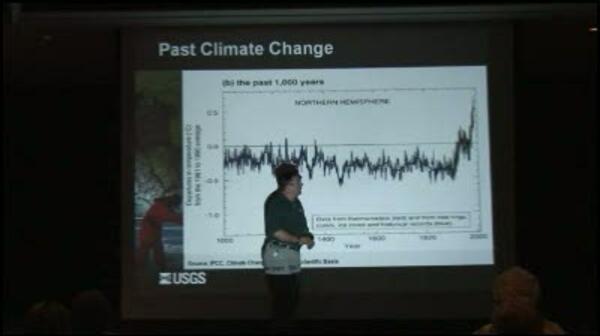 video thumbnail: USGS Public Lecture Series: Climate Change 101
video thumbnail: USGS Public Lecture Series: Climate Change 101
Climate change is an issue of increasing public concern because of its potential effects on land, water, and biological resources.
Climate change is an issue of increasing public concern because of its potential effects on land, water, and biological resources.
 video thumbnail: USGS Public Lecture Series: Watching Nature's Clock: A Citizen-Scientist Effort to Track Seasonal Signs of Climate Change
video thumbnail: USGS Public Lecture Series: Watching Nature's Clock: A Citizen-Scientist Effort to Track Seasonal Signs of Climate Change
USGS Public Lecture Series: Watching Nature's Clock: A Citizen-Scientist Effort to Track Seasonal Signs of Climate Change
USGS Public Lecture Series: Watching Nature's Clock: A Citizen-Scientist Effort to Track Seasonal Signs of Climate ChangeA new USGS program, the USA National Phenology Network, is recruiting tens of thousands of volunteers to team up with scientists to help track the effects of climate on seasonal patterns of plant and animal behavior.
USGS Public Lecture Series: Watching Nature's Clock: A Citizen-Scientist Effort to Track Seasonal Signs of Climate Change
USGS Public Lecture Series: Watching Nature's Clock: A Citizen-Scientist Effort to Track Seasonal Signs of Climate ChangeA new USGS program, the USA National Phenology Network, is recruiting tens of thousands of volunteers to team up with scientists to help track the effects of climate on seasonal patterns of plant and animal behavior.
USGS scientist Karyn Rode takes a blood sample from a polar bear to estimate the diets of wild bears.
USGS scientist Karyn Rode takes a blood sample from a polar bear to estimate the diets of wild bears.
Characterizing urban heat islands across 50 major cities in the United States Characterizing urban heat islands across 50 major cities in the United States
U.S. Geological Survey Benchmark Glacier Project U.S. Geological Survey Benchmark Glacier Project
Monitoring and assessing urban heat island variations and effects in the United States Monitoring and assessing urban heat island variations and effects in the United States
Using information from global climate models to inform policymaking—The role of the U.S. Geological Survey Using information from global climate models to inform policymaking—The role of the U.S. Geological Survey
A record of change - Science and elder observations on the Navajo Nation A record of change - Science and elder observations on the Navajo Nation
Ecosystem vulnerability to climate change in the southeastern United States Ecosystem vulnerability to climate change in the southeastern United States
Desert wetlands—Archives of a wetter past Desert wetlands—Archives of a wetter past
Changing arctic ecosystems—What is causing the rapid increase of snow geese in northern Alaska? Changing arctic ecosystems—What is causing the rapid increase of snow geese in northern Alaska?
USGS Arctic Science Strategy USGS Arctic Science Strategy
Climate change: evaluating your local and regional water resources Climate change: evaluating your local and regional water resources
Changing Arctic ecosystems: resilience of caribou to climatic shifts in the Arctic Changing Arctic ecosystems: resilience of caribou to climatic shifts in the Arctic
Remote sensing of land surface phenology Remote sensing of land surface phenology
Related
What are the long-term effects of climate change? What are the long-term effects of climate change?
Scientists have predicted that long-term effects of climate change will include a decrease in sea ice and an increase in permafrost thawing, an increase in heat waves and heavy precipitation, and decreased water resources in semi-arid regions. Below are some of the regional impacts of global change forecast by the Intergovernmental Panel on Climate Change: North America: Decreasing snowpack in the...
What is the difference between weather and climate change? What is the difference between weather and climate change?
Weather refers to short term atmospheric conditions while climate is the weather of a specific region averaged over a long period of time. Climate change refers to long-term changes.
How can climate change affect natural disasters? How can climate change affect natural disasters?
With increasing global surface temperatures the possibility of more droughts and increased intensity of storms will likely occur. As more water vapor is evaporated into the atmosphere it becomes fuel for more powerful storms to develop. More heat in the atmosphere and warmer ocean surface temperatures can lead to increased wind speeds in tropical storms. Rising sea levels expose higher locations...
What are some of the signs of climate change? What are some of the signs of climate change?
• Temperatures are rising world-wide due to greenhouse gases trapping more heat in the atmosphere. • Droughts are becoming longer and more extreme around the world. • Tropical storms becoming more severe due to warmer ocean water temperatures. • As temperatures rise there is less snowpack in mountain ranges and polar areas and the snow melts faster. • Overall, glaciers are melting at a faster rate...
How do changes in climate and land use relate to one another? How do changes in climate and land use relate to one another?
The link between land use and the climate is complex. First, land cover--as shaped by land use practices--affects the global concentration of greenhouse gases. Second, while land use change is an important driver of climate change, a changing climate can lead to changes in land use and land cover. For example, farmers might shift from their customary crops to crops that will have higher economic...
What is carbon sequestration? What is carbon sequestration?
Carbon dioxide is the most commonly produced greenhouse gas. Carbon sequestration is the process of capturing and storing atmospheric carbon dioxide. It is one method of reducing the amount of carbon dioxide in the atmosphere with the goal of reducing global climate change. The USGS is conducting assessments on two major types of carbon sequestration: geologic and biologic.
Has the USGS made any Biologic Carbon Sequestration assessments? Has the USGS made any Biologic Carbon Sequestration assessments?
The USGS is congressionally mandated (2007 Energy Independence and Security Act) to conduct a comprehensive national assessment of storage and flux (flow) of carbon and the fluxes of other greenhouse gases (including carbon dioxide) in ecosystems. At this writing, reports have been completed for Alaska, the Eastern U.S., the Great Plains, and the Western U.S. Learn more: Carbon Emissions and...
How does carbon get into the atmosphere? How does carbon get into the atmosphere?
Atmospheric carbon dioxide comes from two primary sources—natural and human activities. Natural sources of carbon dioxide include most animals, which exhale carbon dioxide as a waste product. Human activities that lead to carbon dioxide emissions come primarily from energy production, including burning coal, oil, or natural gas. Learn more: Sources of Greenhouse Gas Emissions (EPA)
How much carbon dioxide can the United States store via geologic sequestration? How much carbon dioxide can the United States store via geologic sequestration?
In 2013, the USGS released the first-ever comprehensive, nation-wide assessment of geologic carbon sequestration, which estimates a mean storage potential of 3,000 metric gigatons of carbon dioxide. The assessment is the first geologically-based, probabilistic assessment, with a range of 2,400 to 3,700 metric gigatons of potential carbon dioxide storage. In addition, the assessment is for the...
What’s the difference between geologic and biologic carbon sequestration? What’s the difference between geologic and biologic carbon sequestration?
Geologic carbon sequestration is the process of storing carbon dioxide (CO2) in underground geologic formations. The CO2 is usually pressurized until it becomes a liquid, and then it is injected into porous rock formations in geologic basins. This method of carbon storage is also sometimes a part of enhanced oil recovery, otherwise known as tertiary recovery, because it is typically used later in...
Which area is the best for geologic carbon sequestration? Which area is the best for geologic carbon sequestration?
It is difficult to characterize one area as “the best” for carbon sequestration because the answer depends on the question: best for what? However, the area of the assessment with the most storage potential for carbon dioxide is the Coastal Plains region, which includes coastal basins from Texas to Georgia. That region accounts for 2,000 metric gigatons, or 65 percent, of the storage potential...
How do we know glaciers are shrinking? How do we know glaciers are shrinking?
Repeat photography and aerial / satellite photo analysis provide evidence of glacier loss in terms of shape and area. The USGS Benchmark Glacier project has collected mass balance data on a network of glaciers in Alaska, Washington, and Montana for decades, quantifying trends of mass loss at all sites. Extensive field data collection at these sites includes twice yearly visits to measure seasonal...
Eroding permafrost on Alaska’s Arctic Coast. Inundation of permafrost like this produced subsea permafrost
Eroding permafrost on Alaska’s Arctic Coast. Inundation of permafrost like this produced subsea permafrost
 A Record of Change: Science and Elder Observations on the Navajo N.
A Record of Change: Science and Elder Observations on the Navajo N.
A Record of Change: Science and Elder Observations on the Navajo N.
A Record of Change: Science and Elder Observations on the Navajo N.A Record of Change—Science and Elder Observations on the Navajo Nation is a 25-minute documentary about collaborative studies using conventional physical sciences, combined with tribal elder observations to show that local knowledge and conventional science partnerships can effectively document ecosystem change and determine the resulting challenges to livelihoods.&
A Record of Change: Science and Elder Observations on the Navajo N.
A Record of Change: Science and Elder Observations on the Navajo N.A Record of Change—Science and Elder Observations on the Navajo Nation is a 25-minute documentary about collaborative studies using conventional physical sciences, combined with tribal elder observations to show that local knowledge and conventional science partnerships can effectively document ecosystem change and determine the resulting challenges to livelihoods.&
 PubTalk 6/2017 — Effects of Climate Change: A Scientific Path Forward
PubTalk 6/2017 — Effects of Climate Change: A Scientific Path Forward
PubTalk 6/2017 — Effects of Climate Change: A Scientific Path Forward
PubTalk 6/2017 — Effects of Climate Change: A Scientific Path ForwardTitle: The Effects of Climate Change: A Scientific Pathway Forward
- The frequency of extreme and unpredictable weather events is increasing.
- What are the effects of an increase or decrease in carbon emissions?
- What is scientific research projecting for the future of climate change?
PubTalk 6/2017 — Effects of Climate Change: A Scientific Path Forward
PubTalk 6/2017 — Effects of Climate Change: A Scientific Path ForwardTitle: The Effects of Climate Change: A Scientific Pathway Forward
- The frequency of extreme and unpredictable weather events is increasing.
- What are the effects of an increase or decrease in carbon emissions?
- What is scientific research projecting for the future of climate change?
More than 1,500 walruses resting on shore at Cape Grieg in southeastern Bristol Bay.
More than 1,500 walruses resting on shore at Cape Grieg in southeastern Bristol Bay.
An adult female polar bear and her two cubs travel across the sea ice of the Arctic Ocean north of the Alaska coast.
An adult female polar bear and her two cubs travel across the sea ice of the Arctic Ocean north of the Alaska coast.
Data collected from long distance swims by Polar bears suggest that they do not stop to rest during their journey.
Data collected from long distance swims by Polar bears suggest that they do not stop to rest during their journey.
The Northwest Climate Science Center (NW CSC) is a Department of the Interior (DOI) initiative, sponsored by the USGS and jointly hosted by Oregon State University, the University of Idaho, and the University of Washington.
The Northwest Climate Science Center (NW CSC) is a Department of the Interior (DOI) initiative, sponsored by the USGS and jointly hosted by Oregon State University, the University of Idaho, and the University of Washington.
 What's the Big Idea? — Remote Sensing Understand Climate Change
What's the Big Idea? — Remote Sensing Understand Climate Change
What's the Big Idea? — Remote Sensing Understand Climate Change
What's the Big Idea? — Remote Sensing Understand Climate ChangeZhuoting Wu, research ecologist at the USGS Western Geographic Science Center, explains how the USGS uses remote sensing technology to help Tribal communities better understand the effects of climate change.
What's the Big Idea? — Remote Sensing Understand Climate Change
What's the Big Idea? — Remote Sensing Understand Climate ChangeZhuoting Wu, research ecologist at the USGS Western Geographic Science Center, explains how the USGS uses remote sensing technology to help Tribal communities better understand the effects of climate change.
 Climate Change Impacts on Aquatic Ecosystems in PNW
Climate Change Impacts on Aquatic Ecosystems in PNW
Climate Change Impacts on Aquatic Ecosystems in PNW
Climate Change Impacts on Aquatic Ecosystems in PNWThis webinar was held as a part of the Climate Change Science and Management Webinar Series, a partnership between the USGS National Climate Change and Wildlife Science Center and the FWS National Conservation Training Center.
Climate Change Impacts on Aquatic Ecosystems in PNW
Climate Change Impacts on Aquatic Ecosystems in PNWThis webinar was held as a part of the Climate Change Science and Management Webinar Series, a partnership between the USGS National Climate Change and Wildlife Science Center and the FWS National Conservation Training Center.
 Extreme Climate Events and Species Population Dynamics
Extreme Climate Events and Species Population Dynamics
Extreme Climate Events and Species Population Dynamics
Extreme Climate Events and Species Population DynamicsThis webinar was held as a part of the Climate Change Science and Management Webinar Series, a partnership between the USGS National Climate Change and Wildlife Science Center and the FWS National Conservation Training Center.
Extreme Climate Events and Species Population Dynamics
Extreme Climate Events and Species Population DynamicsThis webinar was held as a part of the Climate Change Science and Management Webinar Series, a partnership between the USGS National Climate Change and Wildlife Science Center and the FWS National Conservation Training Center.

Erosion along Alaska’s Arctic coastline near the village of Kaktovik
Erosion along Alaska’s Arctic coastline near the village of KaktovikNeal Pastick – lead author of the study – investigating erosion along Alaska’s Arctic coastline near the village of Kaktovik. Permafrost-dominated coasts of Alaska have drastically changed as the result of coastal transgression and storm-surge flooding which can result in the loss of cultural sites and damage to infrastructure. Photo by M.
Erosion along Alaska’s Arctic coastline near the village of Kaktovik
Erosion along Alaska’s Arctic coastline near the village of KaktovikNeal Pastick – lead author of the study – investigating erosion along Alaska’s Arctic coastline near the village of Kaktovik. Permafrost-dominated coasts of Alaska have drastically changed as the result of coastal transgression and storm-surge flooding which can result in the loss of cultural sites and damage to infrastructure. Photo by M.
 PubTalk 11/2012 — Understanding Climate-Wildlife Relationships
PubTalk 11/2012 — Understanding Climate-Wildlife Relationships
PubTalk 11/2012 — Understanding Climate-Wildlife Relationships
PubTalk 11/2012 — Understanding Climate-Wildlife Relationships-- are American pikas harbingers of changing conditions?
by USGS Research Ecologist Erik Beever
PubTalk 11/2012 — Understanding Climate-Wildlife Relationships
PubTalk 11/2012 — Understanding Climate-Wildlife Relationships-- are American pikas harbingers of changing conditions?
by USGS Research Ecologist Erik Beever
Tracking Pacific Walrus: Expedition to the Shrinking Chukchi Sea Ice
Tracking Pacific Walrus: Expedition to the Shrinking Chukchi Sea IceSummer ice retreat in the Chukchi Sea between Alaska and Russia is a significant climate change impact affecting Pacific Walruses, which are being considered for listing as a threatened species. This twelve minute video follows walruses in their summer sea ice habitat and shows how USGS biologists use satellite radio tags to track their movements and behavior.
Tracking Pacific Walrus: Expedition to the Shrinking Chukchi Sea Ice
Tracking Pacific Walrus: Expedition to the Shrinking Chukchi Sea IceSummer ice retreat in the Chukchi Sea between Alaska and Russia is a significant climate change impact affecting Pacific Walruses, which are being considered for listing as a threatened species. This twelve minute video follows walruses in their summer sea ice habitat and shows how USGS biologists use satellite radio tags to track their movements and behavior.
Adult female walrus on ice floe.
 Climate Connections: Questions from Glacier National Park, MT (Ep 4)
Climate Connections: Questions from Glacier National Park, MT (Ep 4)
Climate Connections: Questions from Glacier National Park, MT (Ep 4)
Climate Connections: Questions from Glacier National Park, MT (Ep 4)America has questions about climate change, and the USGS has real answers. In this episode of Climate Connections, USGS scientists answer questions gathered from the beautiful Glacier National Park in Montana. Questions include:
Climate Connections: Questions from Glacier National Park, MT (Ep 4)
Climate Connections: Questions from Glacier National Park, MT (Ep 4)America has questions about climate change, and the USGS has real answers. In this episode of Climate Connections, USGS scientists answer questions gathered from the beautiful Glacier National Park in Montana. Questions include:
America has questions about climate change, and the USGS has real answers. In this episode of Climate Connections, USGS scientists answer questions gathered from Puerto Rico. Questions include:
- Why has the rainy season been so long in Puerto Rico?
- How is global warming impacting the island of Puerto Rico?
America has questions about climate change, and the USGS has real answers. In this episode of Climate Connections, USGS scientists answer questions gathered from Puerto Rico. Questions include:
- Why has the rainy season been so long in Puerto Rico?
- How is global warming impacting the island of Puerto Rico?
 Climate Connections: Questions from North and South Carolina
Climate Connections: Questions from North and South Carolina
Climate Connections: Questions from North and South Carolina
Climate Connections: Questions from North and South CarolinaAmerica has questions about climate change, and the USGS has real answers. In this episode of Climate Connections, USGS scientists answer questions gathered from North and South Carolina.
Climate Connections: Questions from North and South Carolina
Climate Connections: Questions from North and South CarolinaAmerica has questions about climate change, and the USGS has real answers. In this episode of Climate Connections, USGS scientists answer questions gathered from North and South Carolina.
 PubTalk 3/2010 — Changing Times-- A Changing Planet!
PubTalk 3/2010 — Changing Times-- A Changing Planet!
PubTalk 3/2010 — Changing Times-- A Changing Planet!
PubTalk 3/2010 — Changing Times-- A Changing Planet!Using phenology to take the pulse of our planet
By Jake F. Weltzin, Executive Director, USA National Phenology Network
PubTalk 3/2010 — Changing Times-- A Changing Planet!
PubTalk 3/2010 — Changing Times-- A Changing Planet!Using phenology to take the pulse of our planet
By Jake F. Weltzin, Executive Director, USA National Phenology Network
 video thumbnail: USGS Public Lecture Series: Climate Change 101
video thumbnail: USGS Public Lecture Series: Climate Change 101
Climate change is an issue of increasing public concern because of its potential effects on land, water, and biological resources.
Climate change is an issue of increasing public concern because of its potential effects on land, water, and biological resources.
 video thumbnail: USGS Public Lecture Series: Watching Nature's Clock: A Citizen-Scientist Effort to Track Seasonal Signs of Climate Change
video thumbnail: USGS Public Lecture Series: Watching Nature's Clock: A Citizen-Scientist Effort to Track Seasonal Signs of Climate Change
USGS Public Lecture Series: Watching Nature's Clock: A Citizen-Scientist Effort to Track Seasonal Signs of Climate Change
USGS Public Lecture Series: Watching Nature's Clock: A Citizen-Scientist Effort to Track Seasonal Signs of Climate ChangeA new USGS program, the USA National Phenology Network, is recruiting tens of thousands of volunteers to team up with scientists to help track the effects of climate on seasonal patterns of plant and animal behavior.
USGS Public Lecture Series: Watching Nature's Clock: A Citizen-Scientist Effort to Track Seasonal Signs of Climate Change
USGS Public Lecture Series: Watching Nature's Clock: A Citizen-Scientist Effort to Track Seasonal Signs of Climate ChangeA new USGS program, the USA National Phenology Network, is recruiting tens of thousands of volunteers to team up with scientists to help track the effects of climate on seasonal patterns of plant and animal behavior.
USGS scientist Karyn Rode takes a blood sample from a polar bear to estimate the diets of wild bears.
USGS scientist Karyn Rode takes a blood sample from a polar bear to estimate the diets of wild bears.


